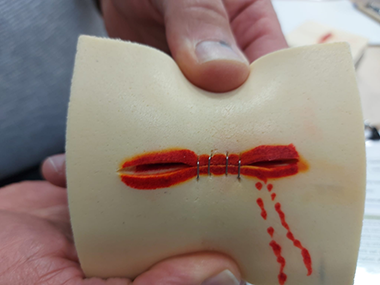Medical training
ALL AROUND YOU BLUE. BLUE SKY, BLUE WATER AND A MAJOR EMERGENCY HAPPENING ON YOUR VESSEL. WHAT DO YOU DO?
Well, we start with taking vitals and ignore any spectacular looking incidents. That is what Dr. Sijbers and his colleague explained us during a very intense full day training. The night before he took us through four hours of possible tooth injuries and solutions, a quick course in understanding medication, and overall medical tips and solutions.
During the day training we had to apply it all in practice. Such as placing a catheter (“just jam it in there! If it’s stuck, jam harder”). Or injecting anesthesia in a painful wound before you staple it shut (stapling is not ideal, but when moving in a storm it can be the best option). While some sailors swear by superglue to close wounds, we were taught that this is probably a bad idea – particularly in warm weather – as in one way or another it is likely to get into an eye or other place you’d rather not have glued shut increasing your problem along the way.
 If all else fails, there's always duct tape. Or stitches, the next best thing.
If all else fails, there's always duct tape. Or stitches, the next best thing.
The training was fun and we’ve got to interact with other sailors, often couples and families, planning to undertake interesting trips. Sometimes in the far future, sometimes for years. We even came across and old acquaintance! Clearly, many people consider taking this leap as the offshore medical course is always full well in advance.
 Helping out getting that numb feeling back again. Yikes!.
Helping out getting that numb feeling back again. Yikes!.
The most likely thing to happen is bumping into something or suffer from an illness you already have. So we’ll instruct all passengers to bring plentiful of their own medicine and to follow our safety instructions. After all, the best way to solve a medical emergency is to prevent it from happening at all.
1st Jan 2023